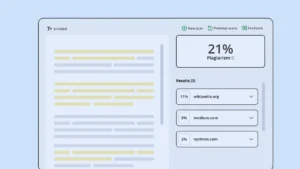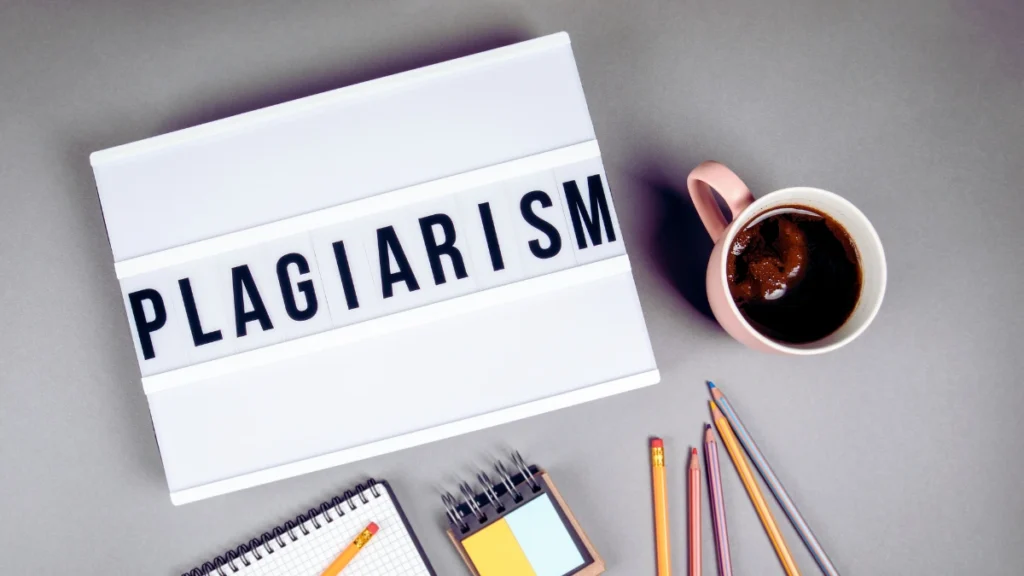In today’s digital world, maintaining content originality has become more important than ever. Plagiarism checkers serve as essential tools for students, writers, and professionals to ensure their work is unique and properly cited. Let’s explore these valuable tools and how they can help protect your intellectual integrity.

What is a plagiarism checker?
A plagiarism checker is a digital tool used to detect and highlight instances of plagiarism within a document.
Purpose: It helps identify any content that matches text from online sources, databases, or previously published works, ensuring originality.
How It Works:
- Scans documents for text similarities.
- Compares the document against a vast database of web pages, academic papers, and other sources.
- Flags any text that matches other content, indicating potential plagiarism.
Key Features:
- Similarity Reports: Provides detailed reports highlighting matched text and its sources.
- Citation Assistance: Some tools help with proper citations and references to avoid accidental plagiarism.
- User-Friendly Interface: Allows easy document upload and quick result generation.
Types of Plagiarism Checkers:
- Online Tools: Web-based platforms (e.g., Grammarly, Quetext) that offer free and premium versions.
- Software-Based Tools: Applications (e.g., Turnitin) commonly used in academic settings.
- Built-In Checkers: Integrated features in certain writing software, like Microsoft Word or Google Docs.
How Do These Tools Work?
Plagiarism checkers employ sophisticated algorithms to analyze text and find matches. When you submit content, the software:
- Breaks down the text into smaller segments
- Searches for matches across multiple databases
- Identifies similar patterns and phrases
- Generates a detailed similarity report
The technology can detect:
- Word-for-word copying
- Paraphrased content
- Rearranged sentences
- Translated material
Read more: The Ultimate Guide to Social Media Marketing: Powerful Strategies for Success
Popular Plagiarism Checking Options
| Plagiarism Checker | Key Features | Database Size | Cost | Best For |
|---|---|---|---|---|
| Turnitin | Advanced similarity detection, comprehensive reporting | Extensive academic databases | Subscription-based | Academic institutions |
| Grammarly | Grammar checking, style suggestions, plagiarism detection | Web pages and academic sources | Free and premium plans | Writers and students |
| Copyscape | Web-based content checking, duplicate content detection | Web pages | Pay-per-use | Web content creators |
| Plagscan | Detailed reports, integration with LMS | Academic and online sources | Subscription-based | Educational institutions |
| Quetext | DeepSearch technology, citation assistance | Academic papers and online content | Free and premium plans | General users and students |
Several tools dominate the market, each serving different needs:
- Academic Tools
- Turnitin: Widely used in educational institutions
- SafeAssign: Integrated with learning management systems
- Professional Tools
- Copyscape: Popular among content creators
- Grammarly: Combines plagiarism checking with grammar correction
- Free Options
- Small Text: Suitable for quick checks
- plagiarism detector: Basic functionality for casual users
Benefits of Regular Plagiarism Checking
Using plagiarism checkers offers numerous advantages:
- Maintains academic integrity
- Ensures original work
- Promotes proper citation habits
- Supports fair assessment
- Protects professional reputation
- Verifies content uniqueness
- Builds credibility
- Prevents copyright issues
- Improves Writing Skills
- Encourages better research practices
- Develops paraphrasing abilities
- Enhances citation knowledge
Read more: Best seo service company in theni
Best Practices for Usage
| Best Practice | Description |
|---|---|
| Upload Final Draft | Run the check on your final draft to catch any unintentional similarities. |
| Review Matches Carefully | Examine flagged content to determine if it needs revision or citation. |
| Use Proper Citations | Add accurate citations for any quoted or paraphrased content. |
| Paraphrase When Possible | Avoid direct copying by rephrasing ideas in your own words. |
| Double-Check After Revisions | Rerun the check after edits to ensure all flagged content is addressed. |
To get the most out of plagiarism checkers:
- Check early and often.
- Scan drafts during writing.
- Verify final versions.
- Use multiple tools for important documents.
- Interpret Results Carefully
- Review flagged content
- Understand context
- Verify citations
- Maintain good writing habits.
- Take detailed research notes.
- Document all sources
- Use proper citation methods.
Limitations to Consider
While valuable, plagiarism checkers have limitations:
- Database Coverage
- No tool covers all existing content.
- Some sources may be inaccessible.
- Recent content might not be included.
- False Positives
- Common phrases may be flagged.
- Technical terms can trigger alerts.
- Properly cited content might be highlighted.
Looking Ahead
The future of plagiarism detection includes:
- AI-powered improvements
- Better cross-language detection
- Enhanced accuracy
- Real-time checking capabilities
How to Use a Plagiarism Checker
Using a plagiarism checker is generally straightforward. Users can upload their documents or paste text directly into the tool. Once the analysis is complete, the checker provides a report highlighting potential instances of plagiarism. It’s crucial to interpret these results correctly and make necessary revisions to enhance the originality of the content.
Steps:
- Upload or Paste Content: Open the plagiarism checker and upload your document or paste the text.
- Select Settings: Choose specific settings (if available), like excluding citations or specific sources.
- Run the check: Start the plagiarism scan; the tool will analyze your content for similarities.
- Review the Report: Examine flagged sections, checking matched content and sources.
- Revise as Needed: Make changes to any unoriginal content, paraphrase, or add proper citations.
- Recheck (Optional): Run a final check after edits to ensure full originality.
Conclusion
Plagiarism checkers have become indispensable tools in maintaining content integrity. While they aren’t perfect, they provide valuable support for creating original work. By understanding how to use these tools effectively and maintaining good writing practices, you can ensure your content remains unique and credible. Whether you’re a student, professional writer, or content creator, incorporating plagiarism checking into your workflow is essential for maintaining high standards of originality in your work.

